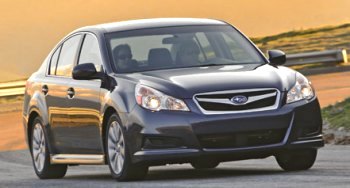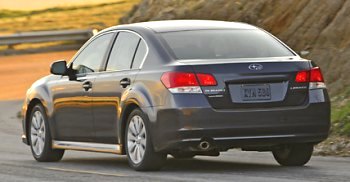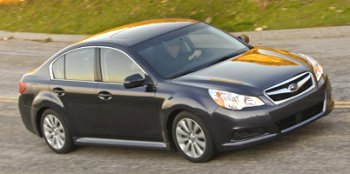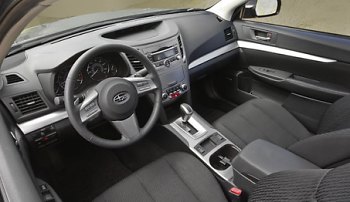Subaru Legacy
Debut: 2009 |
||||||||
Choosing a family car usually involve a lot of calculation in various factors - price, fuel consumption, safety, space, ride, performance, build quality, handling... However, if we let our hearts go first, the answer will be quite simple. You only need to ask yourself two questions: 1) If you were a family car, which one would you want to be? 2) What kind of person do you want to be seen? Actually both questions talk about the same thing. Most people don't want to be seen as average. They want to be remembered when they pass away. Unfortunately, style, technology and quality can get outdated over time - look back to the 1993 Ford Mondeo and you will see how quickly these attributes dated. What really timeless is character. The character of your car speaks of yourself. If you have a neat, attention-to-details character, you had better to choose a Volkswagen Passat. If you are frank and athletic like a cowboy, then Subaru Legacy will be the one. Unique characters help some cars to age better than anything else and keep their owners proud. What makes Subaru unique is obvious - boxer engines and permanent all-wheel drive. Whenever I read these words, I always think of the philosophy running behind them. As the smallest car maker in Japan, Subaru realized that it needs unique technologies and niche products to keep itself independent. Limited resources means Subaru can only offer one platform and one set of technology for all its cars (apart from K-cars), so no matter Impreza, Legacy, Exiga, Forester or Tribeca share the same genes. This leads to a very focused brand character, even more so than German premium brands. If not because of its unique character, we would not have loved the previous Legacy so much. In my eyes, the old car had no special weakness. It just appeared to be a little small compared to its new rivals. Cars in the D-segment have grown significantly during the past 5 years. Their wheelbase has increased from an average 2700 mm to 2770 mm. Many rivals, like Honda Accord, Chevrolet Malibu, Ford Mondeo and Citroen C5, even passed the 2800 mm mark. Development trend points to more cabin and luggage space, better crash protection and upgraded NVH suppression. The new Legacy has to follow suit.
When we saw the first images of new generation Legacy, it raised some eyebrows. You notice its extra size and added bulkiness, not only because it is 80 mm taller and 90 mm wider, but the bonnet is raised by 100 mm in order to comply with pedestrian safety law. Part of this bulkiness is counterbalanced by larger headlamps and sportier wheelarches, but the overall impression is still a heavier car. This is not what we would called a stylish design. However, we do admire the no-nonsense, function-over-form philosophy behind it. Its coherent lines, conventional front grille and large windows prove that Subaru is not obsessed with expressive styling so fashionable in the industry under the influence of Chris Bangle. Perhaps it doesn’t want to distract your attention from its engineering. Apart from taller and wider, the new Legacy is also 80 mm longer in wheelbase as it wants to boost interior space. As expected, its new chassis is made of higher percentage of high-strength steel to increase rigidity. All suspensions are mounted on subframes to reduce noise and harshness. The same goes for the engine, which was previously mounted directly on the chassis. The NVH engineering is apparently far better than the old car. As aforementioned, the Legacy shares key components with Impreza. This mean the MacPherson struts stay up front while the rear suspensions have been changed from multi-link to double-wishbones setup in order to improve wheel control. Most powertrains and running gears are carried over from the smaller car too. No wonder the Legacy is only 50 kg heavier than Impreza. If we say Impreza is over-engineered for its class (especially on refinement), then Legacy is just about right. The new Legacy is still the only car in its class to employ horizontally-opposed (boxer) engines. Although new exhaust connection no longer returns a characterful exhaust note, they still shine for a turbine-smooth operation. At the bottom of the range is a 2.5-liter SOHC 16-valve unit (say goodbye to the old 2.0-liter unit in the Japanese market). It produces the same 170 horsepower and 170 pound-foot of torque as in Impreza. Power goes to a new in-house-built Lineartronic CVT, which, like Audi's Multitronic, uses a steel chain instead of steel belt to handle stronger power and speed up ratio change. On the road, this combination is surprisingly sweet as the boxer engine is smooth and the transmission is seamless. Thankfully, there is no "rubber band effect" displayed by the CVT. It keeps the engine revving linearly according to speed, so you get good refinement all the way. The transmission can also simulates a 6-speed manual gearbox via steering wheel paddles. Manual gearshift is quick enough to give you some fun. We expect the 2.5 engine and Lineartronic can propel the Legacy from 0-60 mph in a little over 8 seconds, matching or bettering its rivals. It also returns good fuel consumption.
However, our focus is always the turbocharged version of the boxer engine. Fast Legacies like RSK or GT-B had always caught our hearts in the past decade. With half a liter of extra capacity and AVCS variable cam phasing at both intake and exhaust valves (previously only on intake side), the new 2.5-liter DOHC boxer turbo does not need to be squeezed to the extreme. Basically this is the same engine as the turbocharged Impreza. In USA, it is tuned to produce 265 horsepower. In Japan, it gets 285 ps - yes, there is no voluntary limit anymore. Both deliver a maximum torque of 258 lb-ft, 5 more than before. Besides, the peak torque is available across a wider range, from 2000 rpm to 5600 rpm (5200 rpm on the American version). Transmission can be a 6-speed manual (compulsory in the US) or optional 5-speed automatic. As before, the 4-wheel drive systems of manual and automatic gearbox are different - the former uses a simple viscous-coupling to split power between front and rear wheels, while the latter uses a planetary gear set within the automatic transmission to do the same task. On the road, the Legacy GT turbo delivers impressive performance. We estimate 0-60 mph can be done in the mid-5 seconds range, thanks to its lightweight (1480 kg for manual or 1510 kg for automatic transmission) and 4-wheel traction. It bridges the gap between sports sedans and V6-powered family cars. The new engine feels stronger and more responsive than the old. Power delivery builds up linearly. Turbo lag is reduced because the turbocharger is connected closer to exhaust manifolds. Throttle response may range from slow to sharp depending on which of the three settings you selected from the SI-Drive system - a kind of switchable engine mapping. To us, Sport Sharp is definitely the default choice, because it is the only mode that allows full rev and horsepower. The other modes are designed for fuel saving in day to day driving. Between the two transmissions, 5-speed automatic is recommended. Its upshift is seamless, while downshift is smoothened by just the right amount of throttle blip. In contrast, the 6-speed manual box is disappointing, blame to its sloppy action and long throw shifter. Subaru has a much nicer 6-speed manual on Impreza STI, but it was considered to be too expensive for this application, sadly.
The last engine is Tribeca's 3.6-liter six-cylinder boxer engine, available only on the North America market and is mandatorily paired with the 5-speed automatic. Yes, its power delivery is even smoother than the 2.5 turbo, but a combination of 256 horses and 1610 kg does not speak of remarkable performance. Its higher fuel consumption and inferior balance also mean it will be a niche choice in a niche car. In my opinion, Subaru could have skipped the six-cylinder engine and put more effort on its forthcoming 2.0-liter boxer diesel, which should deliver more than the 150hp of today. Unless you have an unrealistic idea to compare it with a sports sedan, all versions of Legacy should satisfy your demand for driving fun. Their all-wheel drive systems provide bags of traction. Cornering grip is remarkable as the new double-wishbone suspensions keep the rear wheels in better contact with the tarmac. Braking is strong and fade-resisting. Yes, the body roll may be too much, and the steering could do with more weight, but the big Subaru delivers good road feel and is the only mainstream family car that gives you confidence to attack unfamiliar back roads. Above all, the biggest improved area is comfort and refinement. New suspensions, longer wheelbase and wider tracks contribute to a more composed ride. Extra NVH engineering such as the engine subframe and framed door windows make the interior a much quieter place. The dashboard design and materials might be a little disappointing (note that its basic architecture comes from Impreza), but its cabin is now larger than a Toyota Camry. Rear seat is boosted with 100 mm extra legroom, plus a larger door aperture for easier access. People up to 6-foot 5 will have no problem to fit into the back seats ! While retaining its unique character, the new Legacy has upgraded all the essential areas, making itself more appealing to those having heads over hearts. To me, it is no brainer to choose a Legacy 2.5 GT turbo over a similar-priced Honda Accord V6, because it is far superior in dynamics and equally sounded in most other areas. Even the very good Ford Mondeo can only win on lower-spec models. |
||||||||
| The above report was last updated on 12 Jul 2009. All Rights Reserved. |






